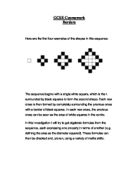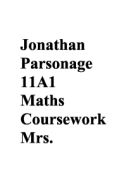The method we shall use begins by looking at the differences between successive terms, and then the differences between those differences, which should (if the sequence is quadratic) be constant. On our table below, the second row of differences is constant at four. We can now determine the coefficient of the in the sequence, by dividing the constant difference by two. Therefore our formula must contain a .
The next step, in order to determine the rest of the formula, is to calculate the differences between the actual areas produced by each value of n and the result obtained by putting each value of n through the function , and put this into a table. These differences should form a linear sequence, of the type encountered when looking at perimeter, from which a formula can easily be derived. This linear formula, when added to the , will give the overall formula for the nth term of the area sequence.
We must now test the formula with the next cross in the series, which has a value of n equal to four.
When we substitute the value four for n in our formula, we get:
If we then count the number of squares in this cross (and hence measure its area), we can see that it is also four. Therefore the formula appears to work.
As with perimeter, we can now look at the formula and obtain some visual understanding of why it works. We mentioned previously that the diameter of the shape could be represented by (2n for either side, 1 for the centre). This is part of our formula. Therefore the remaining part of the cross must be represented by , which easily divides into two equal halves, each thus of area .
The next step is to rigorously prove this formula.
Geometric Near-proof
One way to approach the problem is to look at it geometrically, and apply geometrical theorems and formulae. If we round off the sides of the cross (i.e. remove the discrete square units) and then rotate it by 45°, we end up with a square, and what was previously the diameter across the middle of the cross is now the diagonal across the square.
We know that the diameter is equal to , and therefore this is the length of the diagonal across the square. Using this, we can derive a formula for the area of the square in terms of n.
Pythagoras’ theorem tells us that is equal to (because l forms a right-angled triangle with the square, and l is the hypotenuse while s is the length of both other sides), so we know that . As the area is also , we can say that the area equals . Now l, which is the diagonal across the square, is also the diameter of the cross, which as we have said is , so by substituting this into , multiplying out and simplifying, we get . This final result is, of course, less than the actual formula, because when we round off the edges of the cross to remove the discrete units we also lose some accuracy.
Here we have our smooth approximation of the shape drawn over the top of the actual one; the areas which the approximation leaves out are shaded in black, while those excess areas that it includes are shaded in grey. If we divide up a single square, we see that each of those areas is equal to an eighth of a square, although we cannot really prove it.
So, if we measure the areas excluded and erroneously included, we find that the excluded area is , or 2, while the extraneous area is , or 1.5; the excluded area is 0.5 greater, meaning that the result will always be 0.5 too small. This is why this is not a rigorous proof: because we cannot rigorously prove that this value will always be 0.5. So we must look for an alternative solution.
Series Proof
Going back to the original description of the investigation, we recall that each new cross is formed by surrounding the previous cross with a border of black squares. This means that any cross can be formed by adding consecutive borders around a single square. The number of these borders is equal to n (because the borders are extended away from the centre square, and n represents the number of squares which the shape extends away from the centre). The area of a cross can therefore be represented as the sum of n perimeters of previous crosses. We can write this as a series, using sigma notation, and use standard results to sum it to n terms, thereby proving our formula.
Using our formula for the perimeter of a cross, , we can deduce that a series which sums all the borders necessary to produce the nth cross must comprise of terms produced by the formula taking all the values of r from 1 until n. In sigma notation, this is:
To make this the complete area of the cross, we must then add 1 for the centre square. We can thus write a formula for the area of the nth cross like so:
We must now sum the series to n terms. In that area formula, this should give a result which proves our original formula. To sum it, we use a standard proven result which says that
i.e. that is the sum of the series to n terms. We can use this result to sum our series:
As we can see, when we re-arrange slightly (in order to create something that matches the standard result), substitute in the sum to n, and then simplify, the result is the original formula. Here we have a completely rigorous proof that the area of the nth cross in the sequence equals .
3D
Having derived and proven formulae, expressing the perimeter and area in terms of n for a sequence of two-dimensional crosses, we can now extend this and create a sequence of three-dimensional counterparts in the same way. We begin with a single cube, which is then completely surrounded by a border of black cubes, and then build up a 3D sequence in this way. I will make no attempt to illustrate any of this, as the complexities of accurate three-dimensional drawing are too great, and even with correct, isometric drawings, it is impossible to show the complete shape; diagrams add very little to this section of the investigation.
Volume
For our 2D sequence, our primary goal was to find and prove a formula for area; now it is volume. If we measure the volumes (i.e. count the number of cubes) of each cross in the sequence, we can put our results into a table and derive a formula, as before. After much laborious construction and subsequent disassembly using “multi-link” cubes, the following table was produced:
On this table, the differences do not become constant until the third row. This means the formula is cubic – it contains an (as it calculates volume). We use the same method as previously, but this time, it is more complicated.
As before, we begin by looking at the differences between terms, the differences between those differences, etc. We know that the formula is cubic, as the differences become constant on the third row. We now work out the coefficient of the in the formula by dividing this constant number by six, and this gives us a result of . Next, we compare the actual terms of the volume sequence with those produced by , and construct a new sequence from the differences, which will this time be quadratic. We are now at the stage we were when we began to derive a formula for area. We have a quadratic sequence, and must determine the coefficient of the by dividing the constant difference by two (giving a result of ), before finding the final, linear part of the formula, which is the nth term of the sequence formed from the differences between the terms of the actual quadratic sequence, and the terms produced by . Finally, we add the separate parts together to obtain the formula for the volume of the nth 3D cross.
Proof
We can now prove our formula using a similar method to that with which we proved the 2D formula. However, this time it is rather more complex, as we cannot use a series comprised of the sum of the borders, because we have no formula which gives us the perimeter (or surface area, in this case). We can, though, look at the 3D cross as though it were layers of 2D crosses. We can then build up a formula using a series that sums the 2D crosses which make up the top half of the shape, then multiplying the result by two (for the bottom half), and then adding the area of the 2D cross in the centre. This is made more complex by the fact that, when written in sigma notation, the series takes values of r from zero to , and not from one to n (which, left as is, would prevent us from using any standard results). Because of this, we must modify the series so that r does range from one to n.
So, we begin with a formula which we gives the volume of the nth 3D cross. It contains a series which is the sum of all those 2D cross layers above the middle. This uses the formula we have already obtained and proven for the area of a 2D cross, and, as we have said, substitutes in values ranging from zero to (because the number of these layers must be n, and the smallest 2D layer, because it is a single cube, must use 0 as the value of r). The sum of this series is multiplied by two (to include both above the middle and below it), and then the volume of the central layer (simply ) is added. Written out, with sigma notation, it is:
What we must do next is convert the series so that r can range from one to n. Since the range 0 to is just the same as 1 to n shifted down by one, we can do this by replacing each r in the formula by . We can then substitute in standard results. There are three we must use now, one which we have already come across:
What follows, then, is our final proof:
The result is identical to our formula for volume. Both the 2D and 3D formulae have now been proven.







